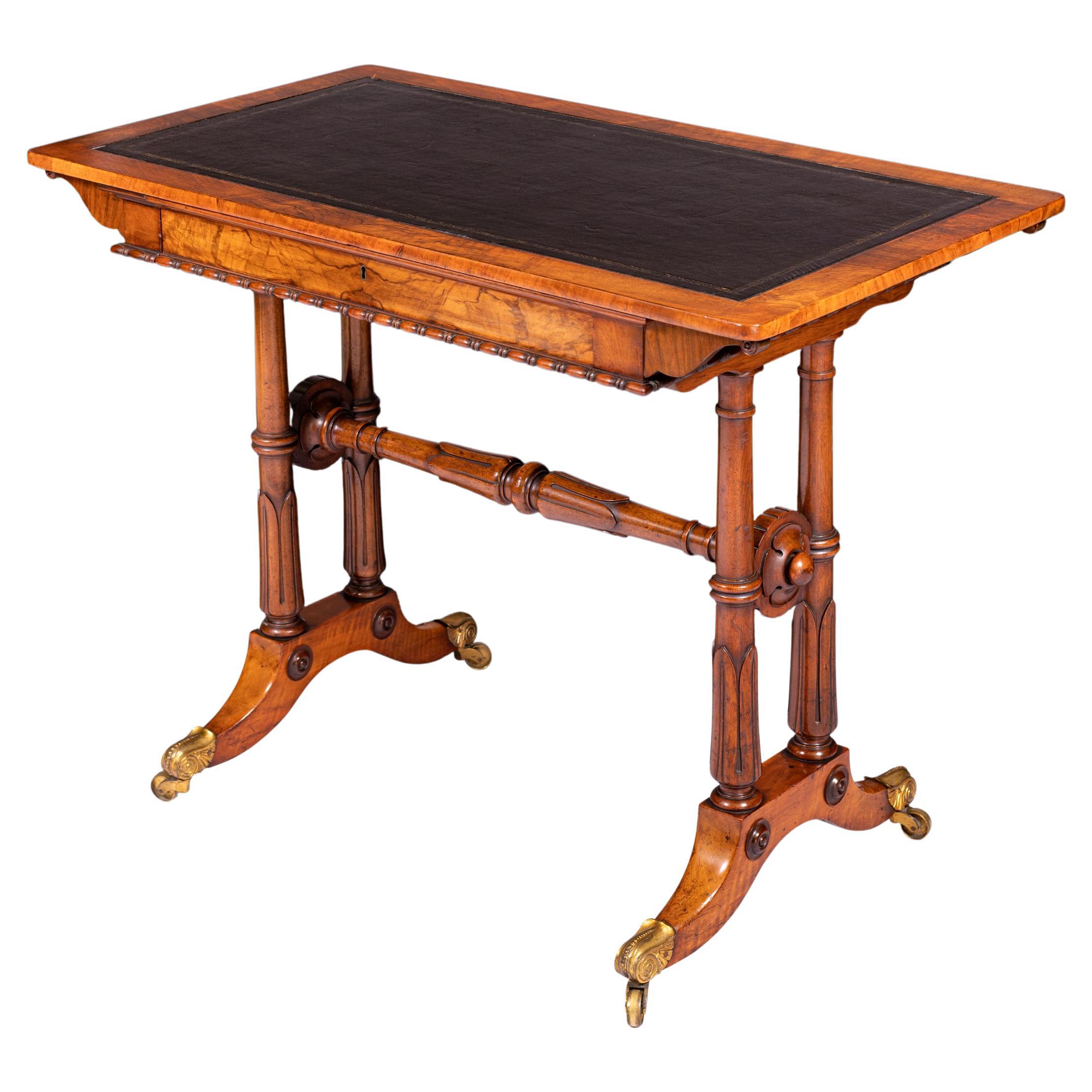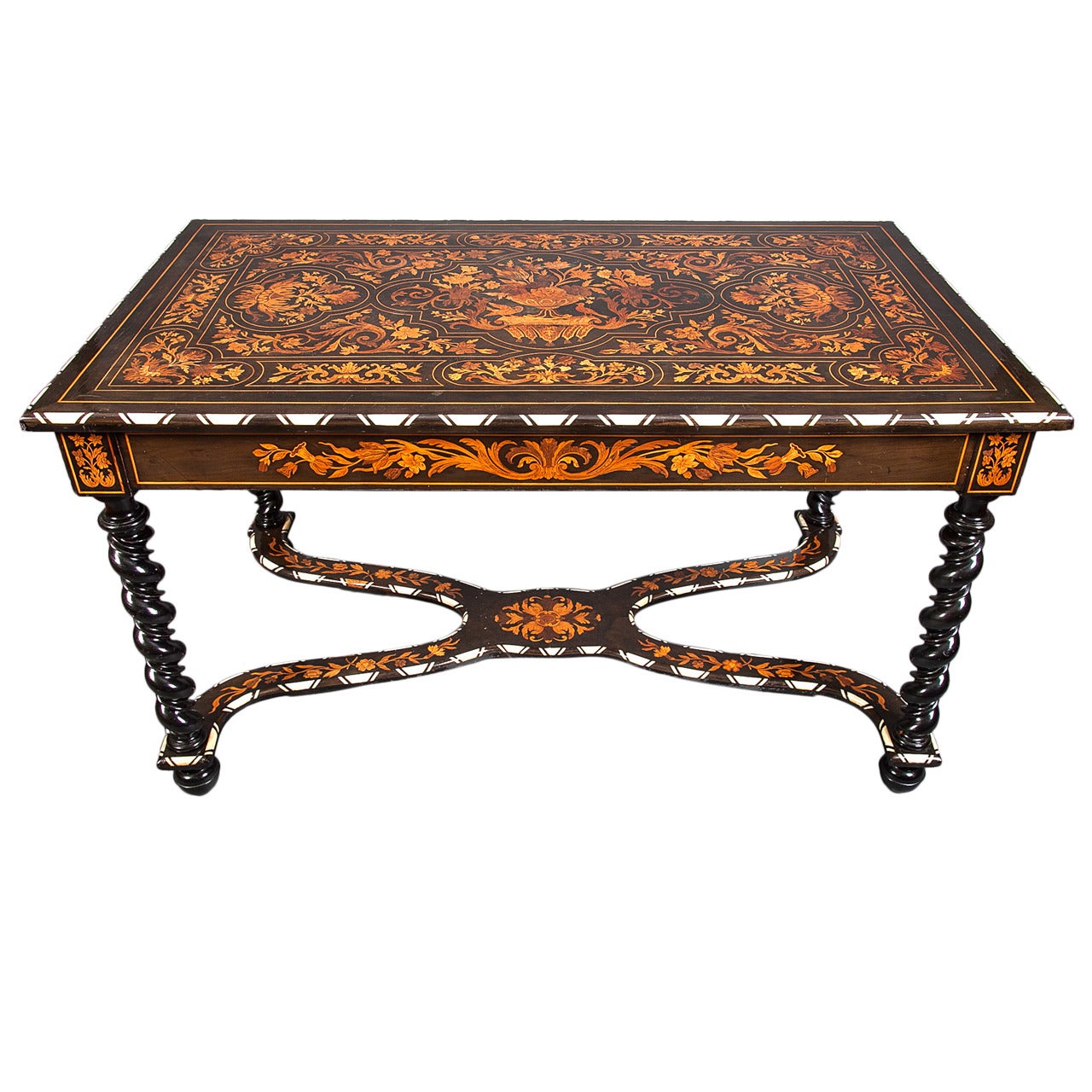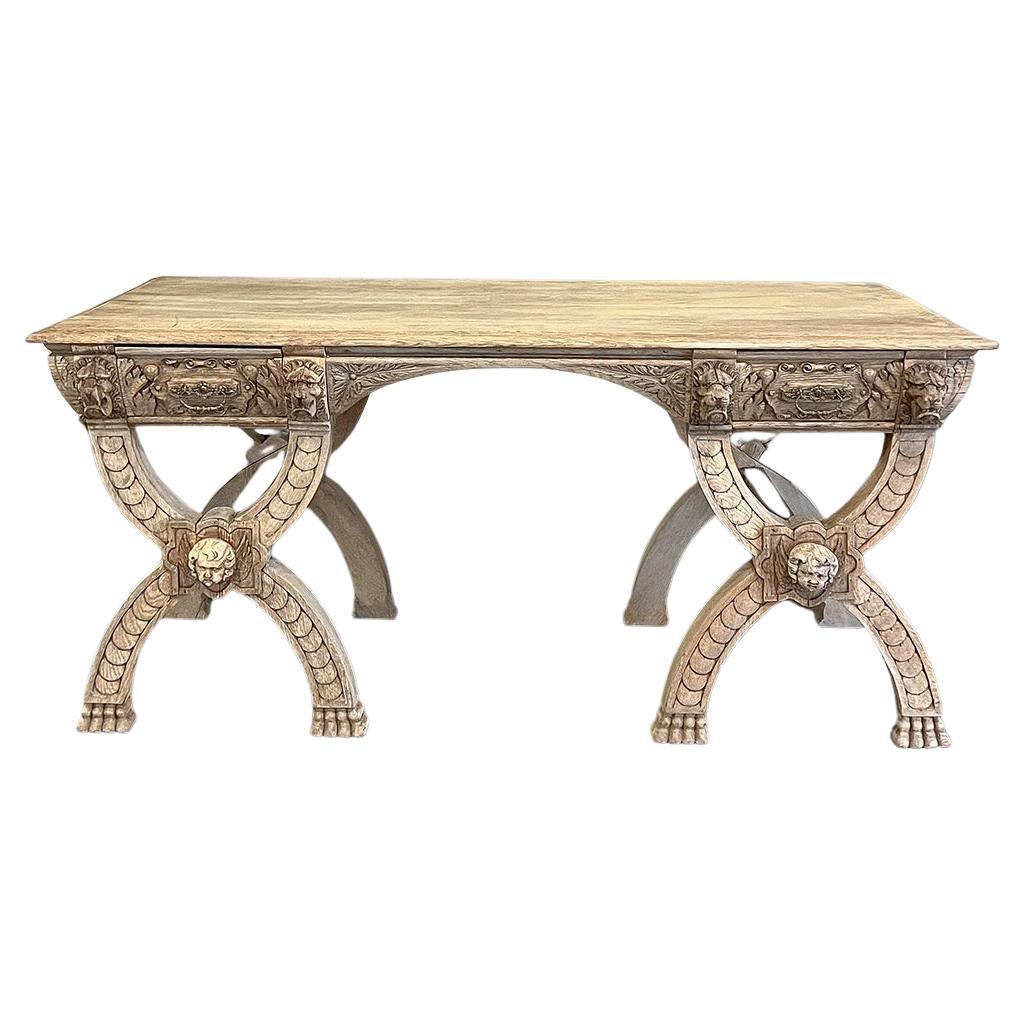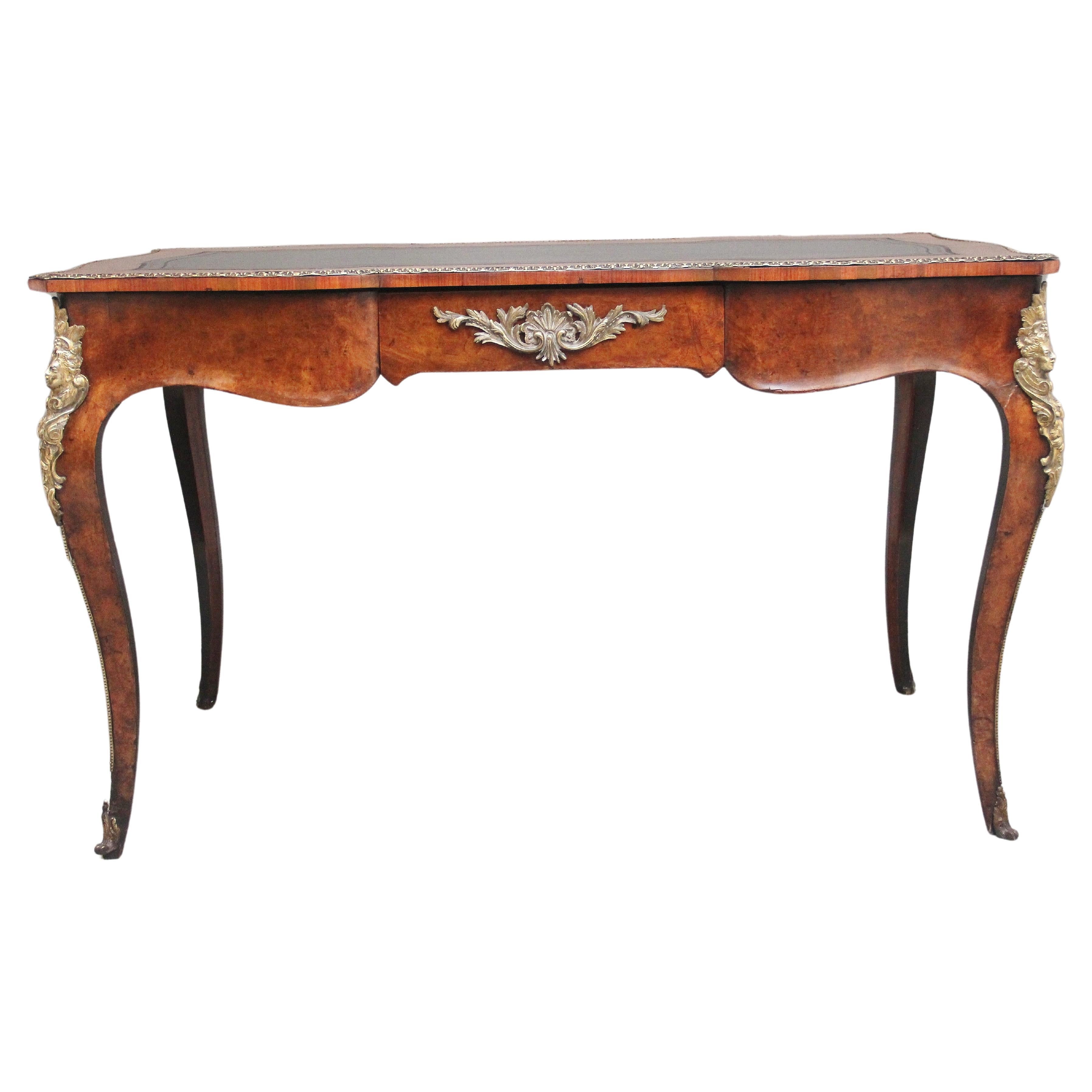Items Similar to 19th Century Marquetry Writing Table in the manner of Holland & Sons
Want more images or videos?
Request additional images or videos from the seller
1 of 8
19th Century Marquetry Writing Table in the manner of Holland & Sons
About the Item
A good writing table in the Manner of Holland & Sons
Constructed in mahogany, with specimen wood inlays, and gilt bronze mounts; of rectangular form, with bowed ends, rising from ring turned, fluted and tapering legs, adorned with bronze swags and ogee bands , and conjoined with a stylised and foliate inlaid 'X' form stretcher; the inlaid apron housing a single mahogany lined long drawer, with an inset morocco leather tooled top within an inlaid reserve, and having a bronze gadrooned guard edge. Circa 1860.
- Dimensions:Height: 31 in (78.74 cm)Width: 55.5 in (140.97 cm)Depth: 31.5 in (80.01 cm)
- Style:Victorian (Of the Period)
- Materials and Techniques:
- Place of Origin:
- Period:
- Date of Manufacture:Circa 1860
- Condition:Repaired: Each item has undergone careful inspection and restoration by a conservation specialist in order to guarantee the original quality and integrity of the object. Wear consistent with age and use.
- Seller Location:London, GB
- Reference Number:
About the Seller
5.0
Recognized Seller
These prestigious sellers are industry leaders and represent the highest echelon for item quality and design.
Gold Seller
These expertly vetted sellers are highly rated and consistently exceed customer expectations.
Established in 1964
1stDibs seller since 2012
42 sales on 1stDibs
Typical response time: 3 hours
Associations
The British Antique Dealers' AssociationLAPADA - The Association of Arts & Antiques Dealers
- ShippingRetrieving quote...Ships From: London, United Kingdom
- Return PolicyA return for this item may be initiated within 3 days of delivery.
More From This SellerView All
- 19th Century Amboyna Library Table in the Manner of Morel & SeddonBy Edwards & Roberts, Morel & SeddonLocated in London, GBA library table in the manner of Morel & Seddon later retailed by Edwards and Roberts Of kidney form, the sled bases, standing on oblate bun feet having spandrel blocked end suppo...Category
Antique Early 19th Century English George IV Tables
MaterialsAmboyna
- English Walnut and Marquetry Davenport Desk, 19th CenturyLocated in London, GBConstructed in Circassian walnut, with line and marquetry inlays; rising from turned oblate bun feet; the lower section housing a hinged door with fretwork panelling, opening to reveal four lemonwood faced graduated drawers with inset turned knobs; the writing compartment braced by foliate spandrels above and below, the slide opening to reveal an easel support writing slope with inset tooled leather and a pen and ink tray...Category
Antique 19th Century English Victorian Desks and Writing Tables
MaterialsWalnut, Leather
- French 19th Century Floral Marquetry and Gilt Bronze TableLocated in London, GBA ladies writing table in the Louis XV transitional manner. Of freestanding form, constructed in kingwood, with good marquetry inlays, and having gilt bronze mounts; rising from swept cabriole legs with foliate form bronze sabots, and foliate espagnolettes over; the apron houses a lockable central drawer, with gilt bronze handles and a keyhole escutcheon; the shaped serpentine platform having a centrally situated floral bouquet, within a trellis delineated ground, the whole having a gilt bronze guard...Category
Antique 19th Century French Louis XV Desks and Writing Tables
MaterialsBronze
- French 19th Century Green Satinwood Marquetry Table with Leather TopLocated in London, GBConstructed in satinwood, with extensive usage of green stained sycamore, harewood, bois Violette, and well cut floral marquetry, the freestanding table rises from bronze capped cylindrical tapered legs, with vertical inlays; the apron, with a running motif of inlaid circles, containing a single mahogany lined single drawer with further bronze highlight: the top is of oblong form with bowed ends, enclosing a tooled hide, with floral marquetry end panels, enclosed by a bronze angle...Category
Antique 19th Century French Louis XVI Desks and Writing Tables
MaterialsLeather, Satinwood, Sycamore
- Superb 19th Century Marquetry Cabinet in the Louis XIV MannerBy André-Charles BoulleLocated in London, GBAn impressive Marquetry Inlaid cabinet In the Louis XIV Manner of André-Charles Boulle Constructed in ebony and ormolu, adorned in première-partie...Category
Antique 19th Century French Louis XIV Cabinets
MaterialsMarble, Brass, Ormolu, Pewter
- 19th Century French Belle Époque Table in the Louis XVI Style by LexcellentBy E. Guillaume-Edmond LexcellentLocated in London, GBA Louis XVI style writing table By Lexcellent of Paris Of restrained elegance and sumptuous finish with gilt bronze mounts, the mahogany-veneered writing table supported on taper...Category
Early 20th Century French Louis XVI Desks and Writing Tables
MaterialsOrmolu
You May Also Like
- 19th Century English Regency Walnut Writing Table in the Manner of Holland &SonsBy Holland & SonsLocated in Dublin, IEA George IV walnut rectangular writing table, the top with inset leather scriver above a shaped frieze drawer, raised on pairs of turned side supports with lotus collars and stretche...Category
Antique 19th Century English Regency Desks and Writing Tables
MaterialsWalnut
- Early 19th Century Dutch Marquetry Writing Table with InlayLocated in Hudson, NYEarly 19th Century Dutch Marquetry Writing Table with Inlay. Stunning example of marquetry craftsmanship with turned legs and inlay on the stretchers. Desk has a single drawer.Category
Antique Early 19th Century Dutch Desks and Writing Tables
MaterialsWood
- 19th Century English Victorian Rosewood and Marquetry Writing TableLocated in Chelmsford, EssexA good quality Victorian rosewood and marquetry writing, having a green leather writing surface, decorated with blind and gold tooling above an arrangement of 9 drawers, each with or...Category
Antique Late 19th Century English Victorian Desks and Writing Tables
MaterialsRosewood
- 19th Century Dutch Renaissance Desk ~ Writing TableLocated in Dallas, TX19th Century Dutch Renaissance Desk ~ Writing Table is truly an intriguing design! Crafted from solid old-growth oak, it features a plank top resting over an artistically sculpted c...Category
Antique Mid-19th Century Dutch Renaissance Revival Desks and Writing Tables
MaterialsBrass
- Antique Victorian Walnut Writing Table Desk Hindley & Sons 19th CenturyLocated in London, GBAntique Victorian walnut writing table, circa 1850 in date. One of the drawers is stamped by the maker: C.Hindley & Sons, late Miles & Edwards, 134 Oxford Street, London. It bears the inventory number 12451 The rectangular top features a moulded edge with a striking inset red leather writing surface over two cedar lined drawers to the frieze, fitted with Bramah locks. It is raised on four decorative barley twist legs terminating in brass castors. It is finished on all sides so that it can stand freely in the middle of a room. Complete with working Bramah locks and special key. Condition: In excellent condition, please see photos for confirmation. Dimensions in cm: Height 76 x Width 123 x Depth 69 Dimensions in inches: Height 2 foot, 6 inches x Width 4 foot x Depth 2 foot, 3 inches Hindley, Charles & Sons Berners Street & Oxford Street, London; cabinet makers, upholsterers and retailers (fl.c.1820-1892) Charles Hugh Hindley (b.1792- d.1871) was the son of Christopher, a merchant in Mere, Wiltshire. He moved to London with an elder brother to live with his uncle, who was possibly running the London branch of the Wiltshire business. In 1817 Charles joined the upholstery firm of Benjamin Merriman Nias at 32 Berners Street. Within a few years he bought the Nias business with a £1,000 investment from his family. Despite his business being described as a 'carpet warehouse' in London directories from 1820-1841, by the mid-1830s upholstery and cabinet work had joined his repertoire and he had taken on more showroom space next door at 31 Berners Street. Family records of the 1840s showed that individual custom-order business expanded to also ‘supplying established furnishing houses with goods on wholesale terms’. Jobs ranged from supplying Pentonville Prison with 100 hair mattresses and pillows, to altering spring roller blinds, to fulfilling private commissions with suites of parlour furniture. Hindley was the father of eleven children with three involved in the business: Charles Hugh (b. 1818), Frederick (b. 1820), and Albert Daniel (b.1822). Charles Hugh and Frederick joined the family firm about 1832, thus establishing the family partnership, Charles Hindley & Sons. Albert Daniel learned the carpet manufactory and trade in Kidderminster and eventually established a carpet manufactory in Liversedge, Yorkshire, supplying the family’s London store and others. In 1845 he patented an early tufted carpeting technique. Charles Hindley & Sons acquired the firm, Miles & Edwards in September 1844, including their premises at 134 Oxford Street. Both companies operated from this address until 1845 when Miles & Edwards was closed. The purchase of Miles & Edwards enabled Hindley & Co. to compete with other West End firms by offering everything from cabinet making and upholstery to painted decoration and interior design for the middle and upper class market. In a sample of 737 orders from October 1842-June 1845, six per cent of the clientele were upper and lower aristocracy with approximately seventy per cent gentry or middle class. The aristocratic clientele included the surnames of Hoare, Kirland, Drummond, Montefiore, Ashburton and Rothschild, and the Oriental Club at 18 Hanover Square (1824). Bramah is London's oldest security company. Established at 124 Piccadilly, London in 1784, and today based in Marylebone, London and Romford, Essex. Bramah made their first lock in 1784 and the patent was awarded in 1787. The designer was Joseph Bramah. Joseph Bramah was a leading inventor of the industrial revolution, patenting over 18 new ideas, including a new valve for the water closet (toilet), the hydraulic pump, a fountain pen, and a fire engine. Bramah also introduced a beer hand pump for use at the bar, to prevent fluid loss when barmen went downstairs to pour a new jug! Due to the quality of his manufacturing, his name became a by-word amongst British Engineers for engineering excellence and many of his inventions are on display in the Science Museum in London. You can find one of his original toilets still working in Osborne House, Queen Victoria's home on the Isle of Wight. The Bramah lock was unique and advanced property and valuables protection enormously. Indeed it was 50 years ahead of any Chubb lock...Category
Antique 1850s English Victorian Desks and Writing Tables
MaterialsWalnut
- 19th Century walnut writing tableLocated in Martlesham, GBA lovely quality 19th Century walnut writing table, the shaped top having a black leather writing surface decorated with blind and gold tooling, finely carved ormolu moulded edge run...Category
Antique 1860s British Victorian Desks and Writing Tables
MaterialsWalnut
Recently Viewed
View AllMore Ways To Browse
Desk In The Form Of
Antique Writing Tools
19th Century Mahogany Writing Table
Turn Of The Century Desk
Writing Table Stretchers
Writing Table Turned Legs
Inlaid Writing Table
Long Writing Desk
Dutch Wood Table
Antique Writing Desk Leather Inset
Long Writing Table
Table Dutch Legs
Marquetry Writing Desk
Bronze Mounted Writing Table
Leather Inlay Writing Desk
Victorian Mahogany Writing Desks
19th Century Victorian Mahogany Desk
Desk With Fluted Legs





